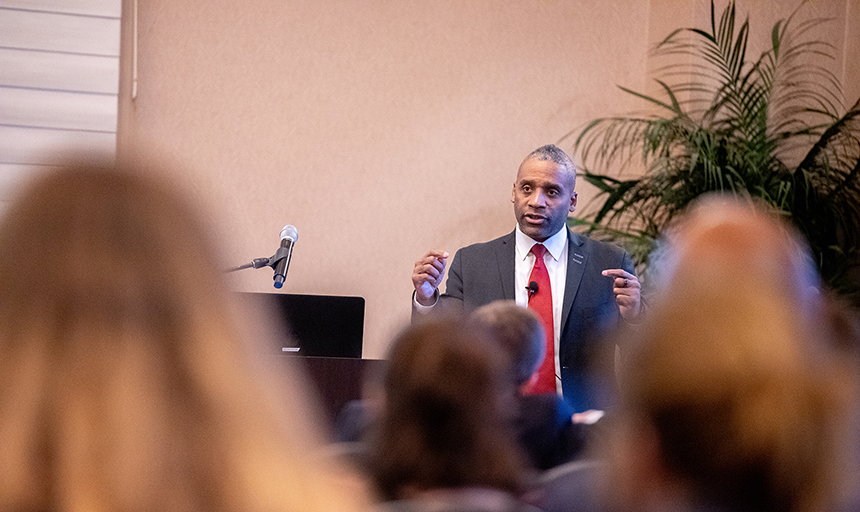Carry offers context for schools confronting complex past
February 09, 2023

Between 2015 and 2020, when dozens of colleges and universities around the country began to formally assess their ties to systemic racism – including monuments to slaveholders and segregationists – higher education administrator Ainsley Carry found himself fascinated by the process.
Carry, who is vice president of students at the University of British Columbia, conducted an in-depth study of that undertaking at 25 American universities, then wove his findings into a 2021 book, “Washington Next? Disputed Monuments, Honorees, and Symbols on Campus.” The book is intended to be a playbook for universities confronting the darkest corners of their past.
On Wednesday, Roanoke College welcomed Carry to campus for the latest installment in the Memorials, Monuments & Memory Lecture Series, which is sponsored by the school’s Center for Studying Structures of Race (CSSR). During his visit, Carry also joined Roanoke professors Carrie Murawski and Alexander Ponomareff for a panel discussion sponsored by the CSSR and the Teaching Collaborative.
"His research and writing are insightful, provocative and practical, and he does not shy away from asking readers to grapple with tough questions," said Roanoke College President Frank Shushok Jr. as he introduced Carry on Wednesday evening. "And one of the things I love about working at a university is that we are capable of – and interested in – struggling with some of the most difficult questions that face us."
Carry, who has more than 25 years of experience in higher education, kicked off his lecture by noting that the CSSR mission is to “expand and complicate” how we research, teach and learn about race.
“Notice the word complicate,” he said. “Usually the intention in teaching is to make something simpler, make something understandable, make something more digestible, not make something more complicated. But in order to grapple with issues of race, culture and memorialization, and how we commemorate that, we have to expand our understanding … Complicating matters means adding scholarship to those issues and then continuing the dialogue.”
Through the CSSR and other initiatives, he said, Roanoke College was ahead of the curve in acknowledging its history. “Most universities respond to these disputes only after the campus protest,” he said. “Your university has been proactive about listening to students and bringing these issues to the table.”
Carry also gave a shout-out to the city of Roanoke, which recently announced plans to replace a memorial to Robert E. Lee with a statue of Henrietta Lacks, a Roanoke native whose cancer cells became the building blocks for some of the most important human cell lines in medical research. “That’s an incredible change for a town to take on,” he said. “I think this small town could lead the country in how to have these difficult conversations.”
But Carry explained that his book is not about advocating for the removal of memorials. Instead, it provides observations about how schools have handled these conversations, and ideas about how those debates could be managed moving forward.
"In order to grapple with issues of race, culture and memorialization, and how we commemorate that, we have to expand our understanding … Complicating matters means adding scholarship to those issues and then continuing the dialogue.”
~ Ainsley Carry

Instead of considering a single question, such as whether to remove the name or statue of a Confederate leader, Carry recommends multi-frame thinking, which invites additional voices to the table for the discussion – voices like those of students, who have been minimized on many task forces established by universities to examine their problematic ties.
“Multi-frame thinking introduces additional voices, but it also introduces additional solutions – things that we would not think about if we just take the single-frame idea,” he said.
Carry’s talk in Wortmann Ballroom on Wednesday, which drew students, faculty, staff and members of Roanoke’s Board of Trustees, outlined four primary frames through which these controversies can be examined. For each frame, he provided examples from situations at universities around the nation.
The principal legacy frame looks at the totality of a controversial figure’s life and puts everything on the scale. The heritage protection frame considers the school’s history and traditions, and whether one particular aspect is worthy of preservation. Landscape fairness weighs how the memorial impacts equity and inclusion for all groups, while the moral standards frame questions whether a figure’s actions should be judged by the moral standards of the past or the present.
“Should we use the standards of the 1850s or should we use the standards of 2020?” he asked. “Better yet, should we use the standards of the future that we want to create? Who do we want to be right now? And how should we examine it?”
Not all of these frameworks end up in the removal of a memorial, he said. They may lead to a decision to contextualize a memorial, add counter-memorials to the campus landscape, or create a museum where the full story can be told.
At Roanoke College, a jury made up of stakeholders from the College, the local community and the arts community is in the process of reviewing concepts for a new memorial that will soon be built on campus to honor the role of enslaved people in the history of the school and the surrounding area. In addition, CSSR last year introduced a walking tour that traces aspects of the history of enslavement on and around campus.
“Roanoke College is one of the few institutions that is doing this proactive thing,” Carry said as he concluded his talk. “I haven’t found many who have said, ‘Let us acknowledge where we are. Let us acknowledge Bittle, Miller and these other halls. Let us acknowledge the quarters for enslaved people that are on campus. Let us acknowledge that the bricks on these buildings were built by enslaved people. Let’s think about the structures and let us acknowledge that. Now, let’s plan for the future that we want to create.”